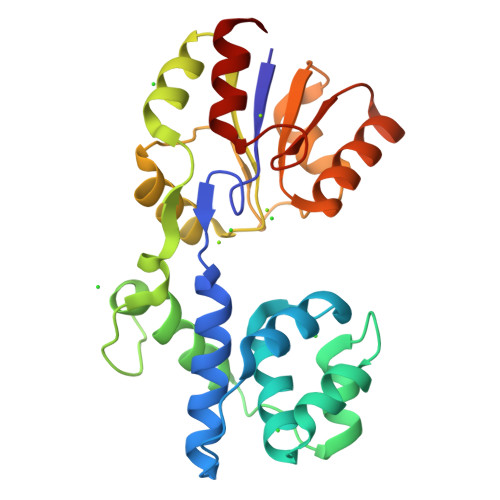A novel structurally characterized haloacid dehalogenase superfamily phosphatase from Thermococcus thioreducens with diverse substrate specificity.
Havlickova, P., Brinsa, V., Brynda, J., Pachl, P., Prudnikova, T., Mesters, J.R., Kascakova, B., Kuty, M., Pusey, M.L., Ng, J.D., Rezacova, P., Smatanova, I.K.(2019) Acta Crystallogr D Struct Biol 75: 743-752
- PubMed: 31373573
- DOI: https://doi.org/10.1107/S2059798319009586
- Primary Citation of Related Structures:
6IAH - PubMed Abstract:
The haloacid dehalogenase (HAD) superfamily is one of the largest known groups of enzymes and the majority of its members catalyze the hydrolysis of phosphoric acid monoesters into a phosphate ion and an alcohol. Despite the fact that sequence similarity between HAD phosphatases is generally very low, the members of the family possess some characteristic features, such as a Rossmann-like fold, HAD signature motifs or the requirement for Mg 2+ ion as an obligatory cofactor. This study focuses on a new hypothetical HAD phosphatase from Thermococcus thioreducens. The protein crystallized in space group P2 1 2 1 2, with unit-cell parameters a = 66.3, b = 117.0, c = 33.8 Å, and the crystals contained one molecule in the asymmetric unit. The protein structure was determined by X-ray crystallography and was refined to 1.75 Å resolution. The structure revealed a putative active site common to all HAD members. Computational docking into the crystal structure was used to propose substrates of the enzyme. The activity of this thermophilic enzyme towards several of the selected substrates was confirmed at temperatures of 37°C as well as 60°C.
Organizational Affiliation:
Institute of Chemistry, Faculty of Science, University of South Bohemia, Branisovska 1760, CZ-370 05 Ceske Budejovice, Czech Republic.


















